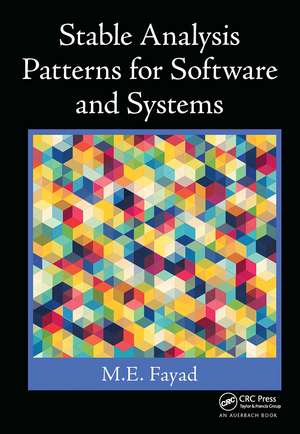Stable Analysis Patterns for Systems
Autor Mohamed Fayaden Limba Engleză Paperback – 21 ian 2023
This book presents a pragmatic approach to understanding problem domains, utilizing SAPs for any field of knowledge, and modeling stable software systems, components, and frameworks. It helps readers attain the basic knowledge that is needed to analyze and extract analysis patterns from any domain of interest. Readers also learn to master methods to document patterns in an effective, easy, and comprehensible manner.
Bringing significant contributions to the field of computing, this book is a unique and comprehensive reference manual on SAPs. It provides insight on handling the understanding of problem spaces and supplies methods and processes to analyze user requirements accurately as well as ways to use SAPs in building myriad cost-effective and highly maintainable systems. The book also shows how to link SAPs to the design phase thereby ensuring a smooth transition between analysis and design.
Preț: 242.85 lei
Preț vechi: 361.87 lei
-33% Nou
Puncte Express: 364
Preț estimativ în valută:
46.47€ • 48.74$ • 38.68£
46.47€ • 48.74$ • 38.68£
Carte tipărită la comandă
Livrare economică 01-15 aprilie
Preluare comenzi: 021 569.72.76
Specificații
ISBN-13: 9781032476803
ISBN-10: 103247680X
Pagini: 340
Ilustrații: 120
Dimensiuni: 178 x 254 mm
Greutate: 0.12 kg
Ediția:1
Editura: CRC Press
Colecția Auerbach Publications
Locul publicării:Boca Raton, United States
ISBN-10: 103247680X
Pagini: 340
Ilustrații: 120
Dimensiuni: 178 x 254 mm
Greutate: 0.12 kg
Ediția:1
Editura: CRC Press
Colecția Auerbach Publications
Locul publicării:Boca Raton, United States
Cuprins
Preface
Acknowledgments
Author
Part I Introduction
Chapter 1 Stable Analysis Patterns Overview
Chapter 2 Applying Analysis Patterns through Analogy: Problems and Solutions
Chapter 3 A Pattern Language for Building Stable Analysis Patterns
Chapter 4 Model-Based Software Reuse Using Stable Analysis Patterns
Chapter 5 Stable Patterns’ Documentation: Templates, UML Forms, Rules, and Heuristics
Part II SAPs: Detailed Documentation Templates
Chapter 6 Competition Stable Analysis Pattern
Chapter 7 Corruption Stable Analysis Pattern
Chapter 8 Dignity Stable Analysis Pattern
Chapter 9 Trust Stable Analysis Pattern
Chapter 10 Accessibility Stable Analysis Pattern
Part III SAPs: Mid-Size Documentation Templates
Chapter 11 Reputation Stable Analysis Patterns
Chapter 12 Temptation Stable Analysis Pattern
Part IV SAPs: Short Documentation
Templates and Future Work and Conclusions
Chapter 13 Analysis Stable Analysis Pattern
Chapter 14 Deployment Stable Analysis Pattern
Chapter 15 Change Stable Analysis Pattern
Chapter 16 Propaganda Stable Analysis Pattern
Chapter 17 Fairness Stable Analysis Pattern
Chapter 18 Anxiety Stable Analysis Pattern
Chapter 19 Future Work and Conclusions
Index
Acknowledgments
Author
Part I Introduction
Chapter 1 Stable Analysis Patterns Overview
Chapter 2 Applying Analysis Patterns through Analogy: Problems and Solutions
Chapter 3 A Pattern Language for Building Stable Analysis Patterns
Chapter 4 Model-Based Software Reuse Using Stable Analysis Patterns
Chapter 5 Stable Patterns’ Documentation: Templates, UML Forms, Rules, and Heuristics
Part II SAPs: Detailed Documentation Templates
Chapter 6 Competition Stable Analysis Pattern
Chapter 7 Corruption Stable Analysis Pattern
Chapter 8 Dignity Stable Analysis Pattern
Chapter 9 Trust Stable Analysis Pattern
Chapter 10 Accessibility Stable Analysis Pattern
Part III SAPs: Mid-Size Documentation Templates
Chapter 11 Reputation Stable Analysis Patterns
Chapter 12 Temptation Stable Analysis Pattern
Part IV SAPs: Short Documentation
Templates and Future Work and Conclusions
Chapter 13 Analysis Stable Analysis Pattern
Chapter 14 Deployment Stable Analysis Pattern
Chapter 15 Change Stable Analysis Pattern
Chapter 16 Propaganda Stable Analysis Pattern
Chapter 17 Fairness Stable Analysis Pattern
Chapter 18 Anxiety Stable Analysis Pattern
Chapter 19 Future Work and Conclusions
Index
Descriere
This book presents a new, pragmatic approach for understanding the problem domain and in utilizing stable analysis patterns for engineering and modeling stable software systems, components and frameworks. The unique template employed in this book for describing the presented analysis patterns makes the use of these patterns easy and efficient. T
